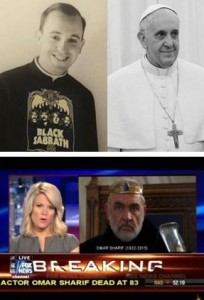Twisting Truth Into Lies
During the past few weeks, I learned that Planned Parenthood is selling dead baby parts as a way to make more profit, that Pope Francis was a Black Sabbath fan, that Fox News published a photograph of Sean Connery when they announced that Omar Sharif had died, and that a man was arrested for a hate crime simply because he burned a gay pride flag. Unfortunately, none of what I learned is true.
The charges against Planned Parenthood were reputed to have come during an interview with Deborah Nucatola, the senior director of medical services at Planned Parenthood, which was secretly recorded by representatives of the Center for Medical Progress. Through creative editing, Nucatola’s remarks were distorted.
 Imagining the Pope—in his younger days—rocking out to Black Sabbath and the image of him wearing a Black Sabbath cassock is something too good not to share. Fox News’ blunder of showing someone other than Omar Sharif fits in with the narrative that Fox News is really Faux News. The screen capture was too good not to share. However, both of these stories are the result of fabricated images.
Imagining the Pope—in his younger days—rocking out to Black Sabbath and the image of him wearing a Black Sabbath cassock is something too good not to share. Fox News’ blunder of showing someone other than Omar Sharif fits in with the narrative that Fox News is really Faux News. The screen capture was too good not to share. However, both of these stories are the result of fabricated images.
The fact that cassocks generally do not sport logos for rock bands—or anything else—should have been the first clue that the image of the future Pope might not be accurate. But why let logic stand in the way of a good story? The error made by Fox News might be more believable because there are documented cases where networks—not just Fox—have made similar errors. Yet a careful reader can see that the image of Connery overlaps the “Breaking News” banner and must have been added to a legitimate screen capture. But why be careful if the image supports a pre-conceived notion?
While it is true that Cameron Mayfield was arrested for a hate crime after burning a gay rights flag, what many conservative news reports such as America’s Freedom Fighters left out is that Mayfield had stolen the flag from a couple’s home before standing in their front yard—late at night—waving the burning flag so that his act could be witnessed by the flag’s owners and their children. The article mentions that Mayfield was intoxicated but neglected to report that he was also charged with resisting arrest.
In “The 14 Greatest Hoaxes of All Time,” Adam K. Raymond writes about the advent of April Fools’ Day.
As Joseph Boskin would tell you, the origins of April Fools’ are murky. In fact, the Boston University professor and pop culture historian was trying to say just that in a 1983 interview with reporter Fred Bayles. But each time Boskin told Bayles that no one is quite sure how the holiday started, the interviewer pushed him for a more concrete answer. Eventually, the academic got fed up with the aggressive questioning and decided to concoct a story worth printing.
Raymond reports that “[Professor] Boskin later said he made the story so absurd that [reporter] Bayles would have to catch on.” But the reporter did not catch on and the story was picked up by the Associated Press.
Raymond also cites the example of humorist H. L. Mencken’s 1917 essay “A Neglected Anniversary” in which Mencken argued that bathtubs only caught on in America after President Millard Fillmore had one installed in the White House. Raymond writes:
Mencken had made the whole thing up. The humorist figured everyone would see through the ruse, and he later wrote that the article was “harmless fun” meant to distract readers from World War I. “It never occurred to me it would be taken seriously,” he wrote.
Recently, someone who should have known better posted a link to a misleading story. When I pointed out that the news report was distorted, the poster responded that the story exemplified a concern they had, but that they should have checked the information more carefully before posting the link.
Although Professor Boskin and humorist Mencken did not expect themselves to be taken seriously, contemporary authors of distorted and fabricated stories are not motivated by harmless fun. Their intent is to be taken seriously. They count on individuals to distribute their creations without taking the time to verify their content.
I help students understand the issue of confirmation bias; especially in terms of the algorithms that search engines use to determine what they think we want to see. As Tomas Chamorro-Premuzic explains, “since online content is often curated to fit our preferences, interests and personality, the internet can even enhance our existing biases and undermine our motivation to learn new things.”
I am not sure if it is fortunate or unfortunate that just following my Facebook news feed produces contemporaneous examples from a variety of points of view that are relevant to current classroom discussions. However, one way in which I teach critical thinking in my classroom is to incorporate misleading, biased, and falsified information and ask students to analyze it.
 As I was drafting this essay, someone posted a meme in Facebook about Southern states, undocumented workers, and slavery which was created by Occupy Democrats. If I were currently teaching early American or nineteenth century American history, I might take the meme to class and ask students to discuss why the logic is problematic. For example, Africa slaves were documented workers who entered the country legally. The meme is both dramatic and a distraction from informed political discussion about twenty-first century immigration, racism, and related issues.
As I was drafting this essay, someone posted a meme in Facebook about Southern states, undocumented workers, and slavery which was created by Occupy Democrats. If I were currently teaching early American or nineteenth century American history, I might take the meme to class and ask students to discuss why the logic is problematic. For example, Africa slaves were documented workers who entered the country legally. The meme is both dramatic and a distraction from informed political discussion about twenty-first century immigration, racism, and related issues.
Incorporating biased materials into the classroom needs to be approached with sensitivity. Yet the discussions inspired by such materials is important in helping students develop vital critical thinking skills.
- –Steven L. Berg, PhD
LEAVE A COMMENT